Hey all, Ryagi here. If you've clicked on this post because you want to see just what modders can do when you let them cook, you're in the right place!
Today we dive into the mods that took part in the Modathon Season 2, modders had only 2 weeks to create these mods. Think game jam but for EUIV mods. The outcome was spectacular, enjoy!
--
Babur’s Gate IV 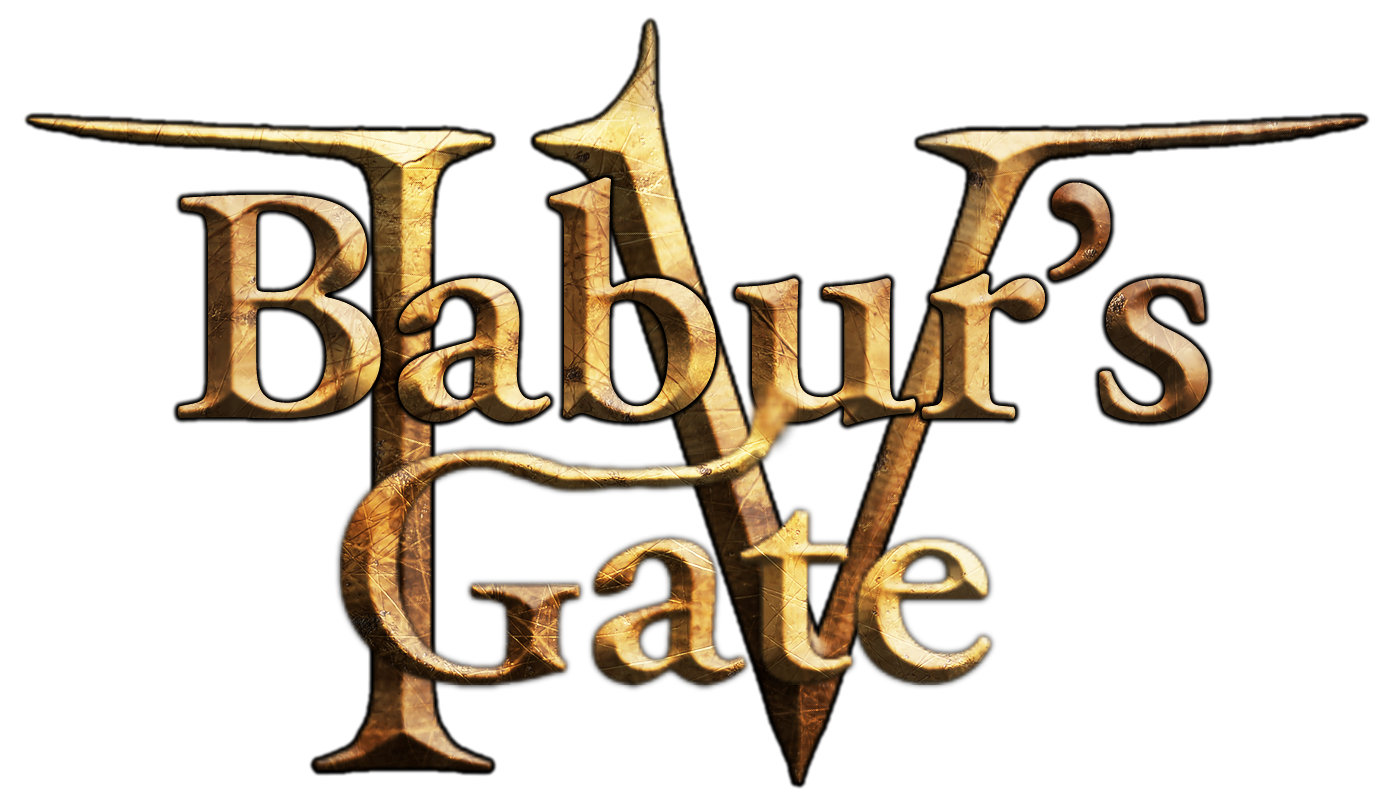
Hello everyone. We are the Babur’s Gate IV team, and today we are honored to present the fruits of our work during the 2024 Modathon - the first (and currently only) Europa Universalis IV RPG: Babur’s Gate IV.
For the 2024’s Modathon we wanted to make something truly impressive and something that would show how far the game can be pushed to its limits. With 1.36, the modding scene has been revolutionized with the addition of custom GUI. Before, possibilities of modding UI were next to nonexistent and such a project as Babur’s Gate IV could not have simply existed.
Gameplay Elements Babur’s Gate IV is an RPG comprises of four core components:
- The Combat System
- The Inventory System
- Custom Map
- Moving Story
Combat System The Combat System, at its core, is based on the D&D combat system, obviously rather simplified due to the limitations that we had to work with. Both the player and enemies take their turn to attack their opponents. Each fight lasts until death so be sure to win them. Shown below is an example of a combat encounter that you can experience in the mod.
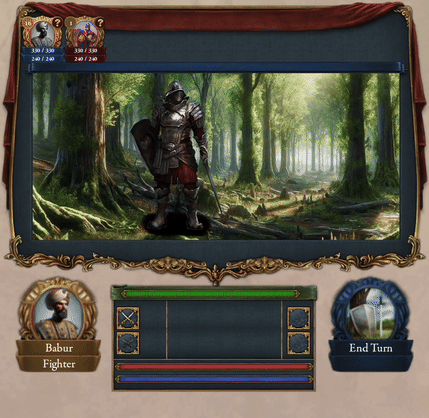
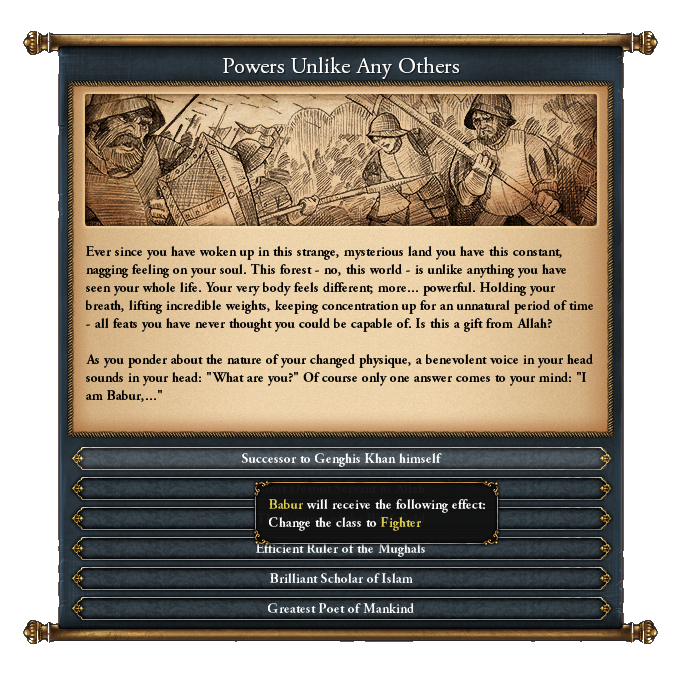 Inventory System
Inventory System An RPG wouldn’t be complete without inventory, equipment and character stats. Here you can manage your items and equip better gear to enhance your fighting abilities. As you can see on the gif below, Babur’s Gate allows you to recruit two other characters to your party as you progress the story. Inventory window is also where you can check characters’ stats, like their health, and spend skill points gained from leveling up. We managed to add a rather limited, but still quite impressive from the technical side, crafting system.
 Custom Map
Custom Map Making an RPG required a new map, specifically designed to be as immersive and as realistic as possible within the limits of EU4. Obviously the game wasn’t designed to handle such changes without any issues but we managed to use some of the vanilla mechanics, like the terra incognita to hide part of the maps the player shouldn’t see from the beginning. Instead they discover all paths in a seamless way by just moving their unit.
A map without any environment objects would feel too empty. That’s why we needed to fill it with many custom made (and some borrowed) 3D objects. Some of them are even interactable like berry bushes from which you can pick berries.
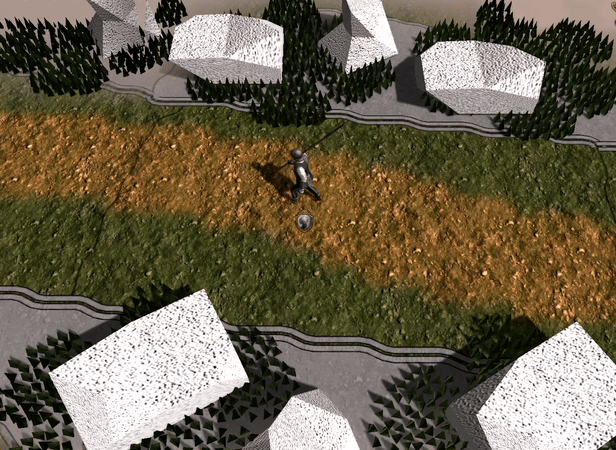 Moving Story
Moving Story No Role-Playing Game would be ever complete without a story. Despite the time constraints, we were able to (mostly) fit the world with plenty of characters and dialogue options, giving your existence in this game a purpose.
In Babur’s Gate IV, you get thrown into an unknown world as Babur - a powerful Indian King who died to an unfortunate Pretender Rebellion. After his unfortunate demise, he finds himself in a foreign forest without anyone from his entourage and without any of his mortal possessions. Will he manage to find his way out of this foreign world? Find out yourself!
The mod includes about 65 unique dialogue options and ~50 NPCs to interact with.
 Future of the Mod
Future of the Mod For the four of us, Babur’s Gate IV was a showcase of the EUIV modding capabilities and a lovely project to tackle for two weeks. As it stands, none of us has got the time nor motivation to continue the development of the mod. As such, if there are any souls willing to make their own EU4 RPG using Babur’s Gate IV systems’, they are free to do so with the appropriate credit.
The task might seem daunting at first, but with much of the work done & functional, further development would be more focused on the development of a new story and new fights/items rather than working from the bottom-up.
For any further inquiries, feel free to leave us a comment on our workshop page.
Our Team
- CzerstfyChlep
- Stiopa
- Comrade Flan
- Lia
Pax Sinica Et Romana Hello fellow romaboos, I am Lichark and in this portion of the spotlight I’ll shed some light on the development and features of Pax Sinica et Romana!
The team Before we get into the meat of this spotlight, I would like to introduce the team and their roles during the modathon.
Me and Tomaszrock22 already had some experience with modding Paradox games in the past, mostly with Hearts of Iron IV. While I’m a jack of all trades kind of developer, Tomasz became kind of an expert at map modding. Sadly, we had to divert from our earlier designs that contained more drastic map changes (provinces, impassable terrain, etc.) so he could help with the development of the mission tree instead.
Juisztánosz and Kindiman were introduced to modding during the modathon so they had to learn on the fly. Still, their help was invaluable during the design phase and later on. When they became familiar enough with event modding they did most of the skeleton work for those, which was not an easy task! The two of them also acted like a kind of research department in the team, looking at cool ideas to include.
Inspirations & Early designs Even during our first brainstorming session we agreed on some foundations for maximum winning potential:
- Rome must be included in some way, everyone loves Rome!
- It should have at least one unique mechanic or a base game/DLC mechanic used in a new and creative way.
- Lots of flavor text and wacky characters/happenings.
After the basics were agreed upon, we had to come up with a scenario that was fun and interesting enough. Juisztánosz wanted to center the project around the Byzantine empire but that would have meant that we had to restructure the content that is already there in that region.
That's when we came up with the whole Sino-Roman empire shtick. We did some research to build a timeline of events that could lead into this scenario, no matter how unbelievable it is. At that time, I thought the best approach to this would be a slow buildup just like how the mod, “Third Odyssey” (Shoutout to the team behind that mod!) does it with a series of events at the start of the game.
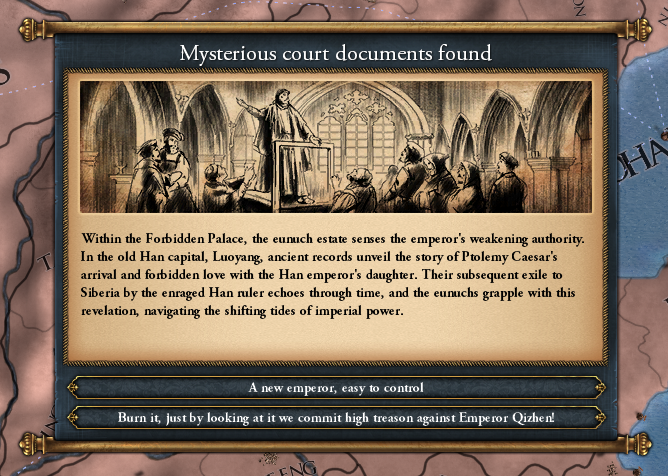
(The event that would have decided if the player goes down the normal Ming or the Serican path)
That meant that the player starts as Ming and with a series of events has the choice to prepare an expedition to find the long-lost Sino-Roman heir in Siberia. After that, they became a one province minor in the region with the goal of reclaiming all of China. This concept failed for a few reasons:
- Early wars were not fun.
- The execution of the expedition was not reliable and would often fail.
- It took too much time to get into the interesting part of the content. We made the mistake of developing this concept for too long and mismanaging the time we had. Because of this, we had to play way safer and remove the majority of our planned content.
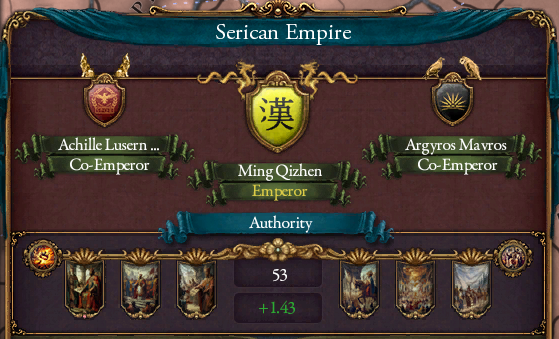
(The co-emperor mechanic that was nearly done by the time we had to cut it due to time constraints)
After thinking it through why our first try didn’t work out, we had an emergency brainstorm. There we made the following changes to the scenario:
- Serica has to exist in the 1444 start date, so the players can engage with its content from the start.
- It has to be balanced somehow, so it’s not too overpowered with all the lands it controls.
- It shouldn’t be particularly hard to get through the mod, it should be just a fun, one-time playthrough with a few fun additions. With these changes and not much time left we started working!
Friends & Foes 
(Map of Asia in the 1444 start date)
With the map finalized, we thought it would make it even more interesting if we created country-dynamics between Serica and the nations around it. We made sure to give the player the option to fully annex or vassalize these nations for roleplaying reasons.
Here’s a quick run-down of the three main nations around Serica:
- Nihon is meant to be the Carthage to our Serica. During the Sengoku period Romans not only settled in mainland China but in the western Japan too. With their technological and military prowess Ouchi managed to unify most of the region. Their goals are to challenge the Serican power structure.
- Mongolia is an interesting nation because it was inspired by the Great Khan Crisis in Stellaris. They were dormant for a time, not attacking anyone or being a threat. If left unchecked they have the opportunity to become a formidable force once again.
- Xinzhong is a monastic order with the Grand Sage leading it. After the proclamation of the Serican empire, the last line of the true Han dynasty fled west and took over a large chunk of the empire. They despise everything Serica and the Roman settlers stand for.

(The five unique advisors available to hire)
During your conquests there will be times where you have the choice to hire unique advisors in the style of Paragons from Stellaris. They have a bit more personality, some kind of useful ability, and a custom portrait. Some of them even unlock new local organizations.
It’s no secret that I’m a common monument enjoyer. That’s why I decided to include 26 new monuments if we’re not counting the different variations of them. These monuments can be grouped into three different categories:
- Present on the map at the game start but can be changed or altered in some ways over time.
- Base game monuments with altered visuals.
- Monuments that have their own upgrade path.
A large majority of these monuments are unlocked with the religious part of the Serican mission tree.
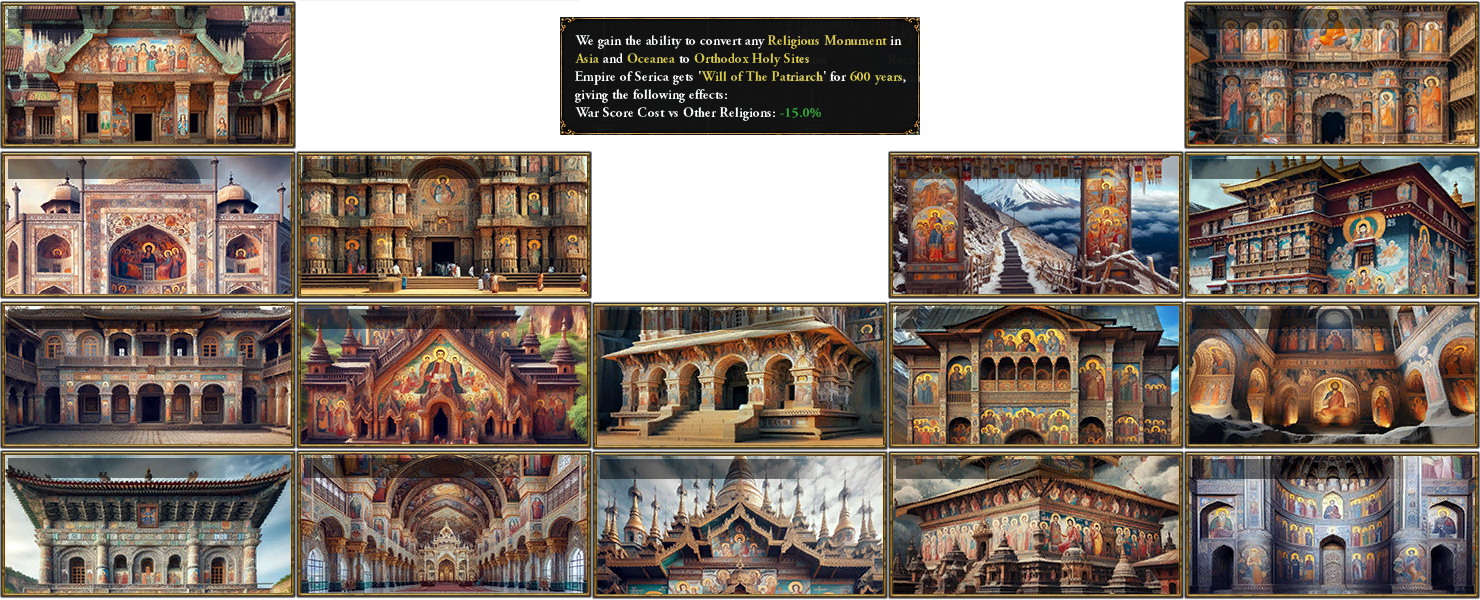
(All the monuments the player can convert with the “In the Name of God” mission completed)
I would like to mention two monuments that have their own, unique properties.
Xi’an Fortified Mountain Pass:
- This monument is vital at the beginning of the game to repel Mongol attacks but later on loses its importance, so the player can repurpose it to fit their playstyle or destroy it and use the resources for other constructions.
Ruins of Beijing:
- Most of us associate monuments with bonuses, we tried to change that with this one. At first it only gives negative modifiers to the province and state. The player has to actively improve it and build it up to restore the city. Once the restorations are over its upgraded to the “Eternal city of Beijing”
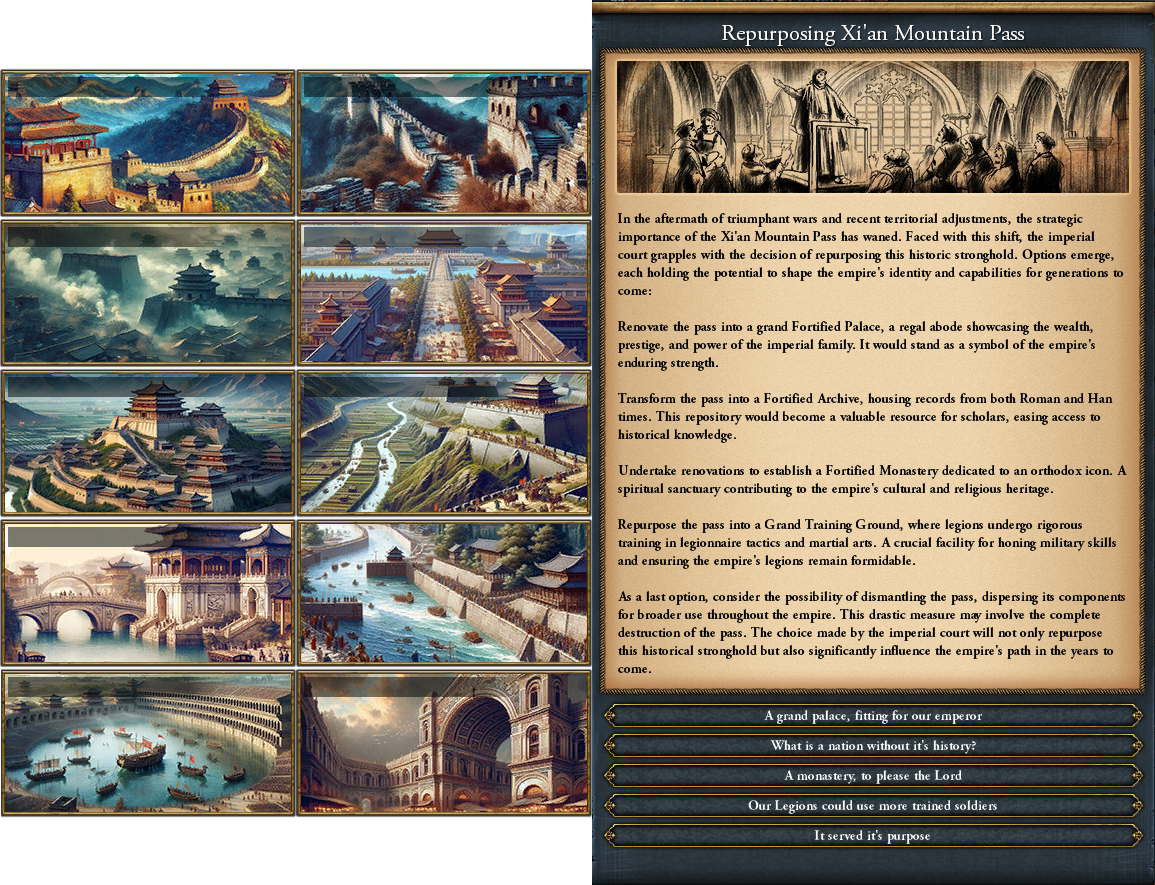 Closing thoughts
Closing thoughts Looking back, the modathon was a great opportunity for our team to work together and have fun. We experienced a ton of hardships over those two weeks but at the end we actually managed to deliver a somewhat cohesive mod.
I would like to thank Chewy, Minnator, Ryagi and Paradox for the opportunity!
Have a good Day!
Lichark
Winds of Silk Well hello to everyone who has decided to read this far, it is me Kyhler, back again with more music but this time from the modathon season 2. I have this time been assisted by three others (Byter, Byrd/valdermarhvidjr. and Crack Jeezus) in the creation of these three new tracks. Remember to give them a listen if you haven’t (either through the mod, or on
youtube or both ;) ) and we hope that you also learn something from reading this, since there might be some new knowledge for you further down. Enjoy!
A Journey Begins “A journey begins”, as the title emplies, had to give you a feeling of leaving home for the new journey. Specifically leaving ones home in the eastern part of the silk road, aka China. This was quite a difficult thing to do since on one hand it had to be a little sad because of you leaving your home, but it also needed to capture a feeling of the ‘epicness’ of the journey ahead of you.
These prerequisites is why the song, fundamentally, can be split into two sections with the split occurring at around 1:13, with the introduction of a new idea into the mix. The first section appeals more to the sadness of leaving all you know, while the second part ramps up in both tempo and instruments used to convey that the journey will also be an adventurous one.
I at last want to mention a small bit about instrumentation itself since as you might have discovered one of the instruments might sound a bit unfamiliar to you.
Hustle and Bustle In Europe This piece is supposed to catch your arrival in europe. You travel through a town and its local market before arriving at the regional city’s busy main-marketplace. As you leave the hustle and bustle of the city behind you, you finally arrive at your destination late in the evening.
As my goal is to educate others, I want to give some insights into the creation process, more specifically into the choice of instruments.
Choosing instruments always depends on a lot of factors. The first question for this decision was “which instruments does EU4/Andreas Waldetoft choose to give a feel of early modern era and EU4?”. The answer I found was “flute and lute”. Now comes in the restriction that I don’t have good sounding sound libraries for lutes, so I just compensated this by a harpsichord, which to the untrained ear (including myself) sounds similar enough. It fits the timeframe anyway. So flute and harpsichord were going to be my main instruments.
But which one should I take for the fuller sections? The answer was simple: strings. They play this very simple rhythm starting at 1:20. I also want to highlight the horns that play a secondary voice (1:34) at first and later on the main voice(1:43). Lastly, listen carefully at 1:25. The flute is not alone anymore, it is reinforced by a piccolo flute.
I only touched the surface of my decision process and instrumentation techniques. If I got your interested for music, try to find specialties while listening to “Hustle and Bustle” yourself. If an instrument appears or disappears, moves into the foreground or stays in the background, mimics another instrument or slightly differs, see what you can find. And give the other two tracks a listen, too. ;D
Lastly, some basics about instrumentation: Not every instrument can play any note. Some notes are just too high or too low to be playable for certain instruments. This is why most instruments have differently sized versions of themselves. The violin for example is smaller than the viola is smaller than the cello is smaller than the double bass. There are also some exotic variants like the contrabassoon (a very deep bassoon) or the piccolo trumpet (a very high trumpet)
Danger in the Mountains - A call for war As the title refers to, this piece is meant to symbolize the start of a longer conflict between two warring countries. The timpani play a heavy part in this piece as to be the heavy march but also to take the role of an actual war drummer that would rile up his compatriots. There are also later parts of the track, where the horns take over and take us to the later stages of the war with both sides experiencing losses. But even in the sight of these losses, war must always have a winning and a losing side
Closing thoughts Well we all hope you overall liked this section of the modspotlight and have a good time reading the other mods. PS. as mentioned before, you don’t even need to download the mod on steam to listen to them since they are on youtube aswell. You can find them on this channel
https://www.youtube.com/@Kyhler and again, thanks for reading so far.
Professional Armies Hello, fellow mod enthusiasts! We are 200e200w, Gandalf, Rocksauze, JustFalcon and AllenY, creator team of Professional Armies, a mod idea which aims to expand the army system, by adding a few new mechanics (like army doctrines) and changing how warfare works a bit. It does not aim to completely revolutionize the army mechanics, but to make them fresh and easy to understand!
Design 200’s initial pitch involved adding new warfare mechanics, specifically HOI4-style doctrines. During our day 1 meeting, we expanded the scope to include an experience system that could be invested into three sinks - the aforementioned doctrines, temporary buffs and permanent unit upgrades, as well as minor adjacent features like idea synergies, government reforms and a new building.
The mod is largely unchanged from its original design draft. We considered adding more features like naval doctrines, logistics, a warscore rework and a stagnancy feature but these were stretch goals from the start and either got axed or we just didn’t have time to implement them.
Speaking of time constraints, the modathon offered a unique challenge that shaped the workflow of our group. We had difficulties getting everyone together for meetings (especially due to being spread over 3 different continents), we had to thoughtfully allocate our time to spend on the mod and we had to learn how to use GitHub the hard way. Every day was precious. But this defining element of the modathon is what allowed our project to be what it is: it forced us to break down our design into tight, simple modules that could be worked on independently, it got us to contribute something every day to keep progress going, and saved us a lot of time deliberating over what could have turned into bloated features. Most of us weren’t developers before the modathon, with 200 being the most experienced modder in the team, but we learned through a trial-by-fire how to code, organise, communicate and, in essence, make our own mod.
Showcase The mod mostly happens on this screen. The vertical bars show the progression of your chosen doctrine, which gives army-wide buffs depending on its nature. The horizontal bars show the progression of your unit professionalisation, which only benefit specific unit types. The five buttons in the bottom right are temporary buffs for occasions where an immediate cheap benefit would be more beneficial than a long-term investment.
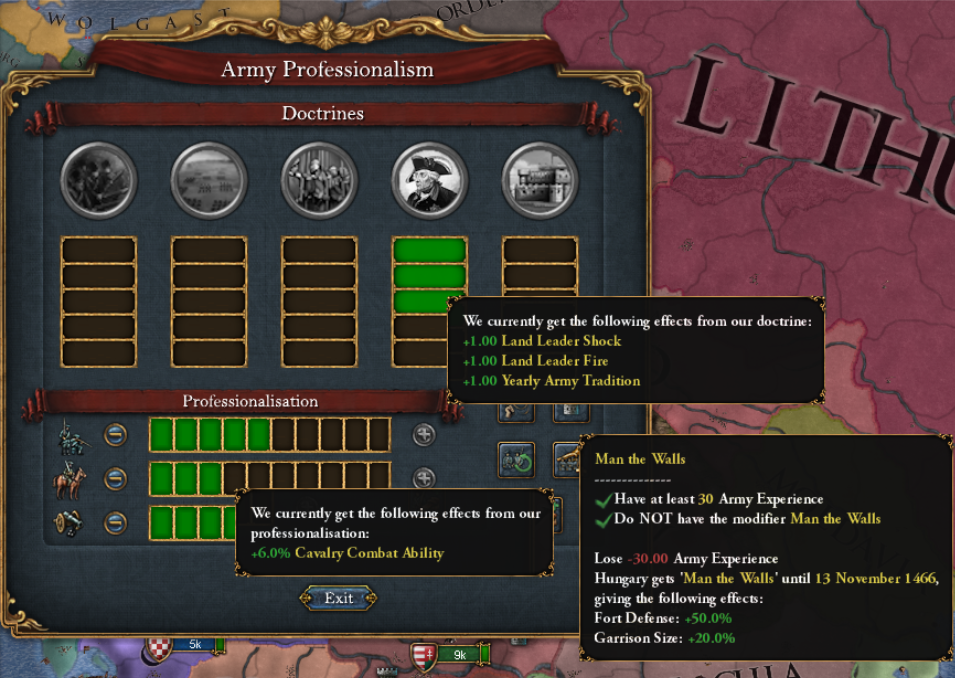
The investments into your military are purchased by spending experience, which is tracked in the military tab. It can be acquired both actively and passively through various means, such as battles and events.

The military academy is a building which passively grants experience, though only one may exist in your country.
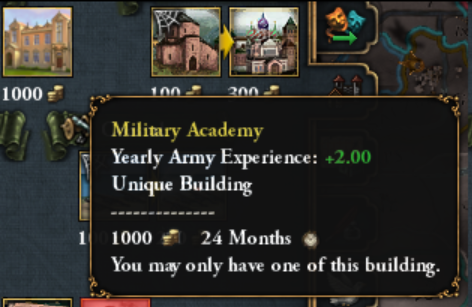
In addition, each of the army doctrines you can take, synergizes with one of the military idea groups, further boosting the doctrine bonuses!

There are also a few more smaller features you will like!

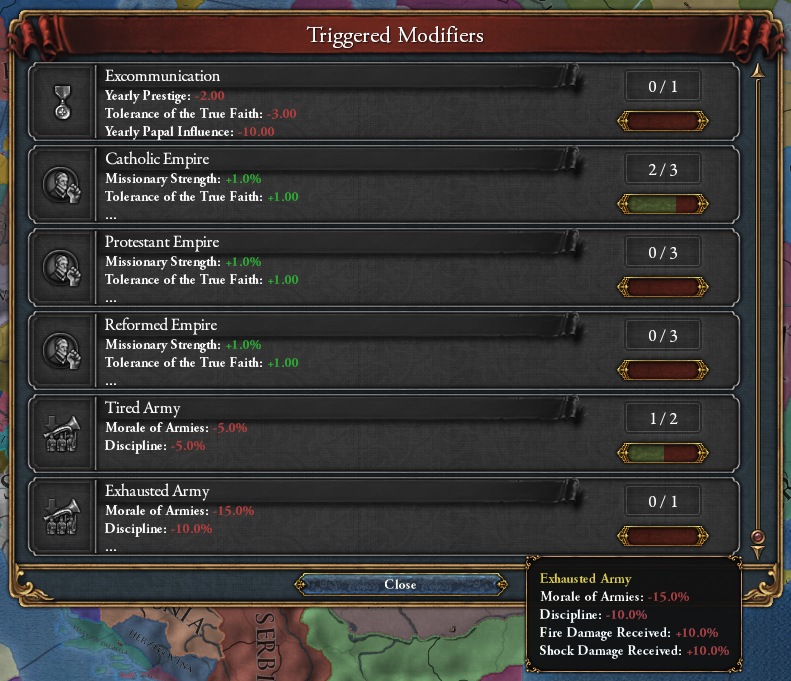 Future
Future In response to player feedback, we plan to change some aspects of the mod to improve the compatibility, balance and UX.
First of all, the military academy is the only building we made and it can only be built once per country. In retrospect, it doesn’t make much sense to mess with the construction interface on such a small change, so we are considering to turn the academy into a decision instead.
Secondly, the rate at which experience is gained and lost will be adjusted. As of now, it is pretty easy to finish an entire doctrine tree within just 100 years, when it should be a process that lasts into the endgame. Expect costs to increase and gains to decrease.
Finally, the doctrine overview window will need to be reworked if we want to show the effects of doctrines ahead of time. This isn’t a massive priority but it is something we want to do.
Retrospective 200e200w - This was my second Modathon, and I had a good experience in EU4 modding! However, this project forced me to learn about what I lacked experience in - UI modding. Learning this allowed me to start creating a custom GUI for our mechanics, which my teammates further polished later on. Being the most experienced member of our team, I was also the person that did most of the coding, especially regarding the more intricate parts of Professional Armies. I felt really happy that people liked our lightweight mod! But I felt happiest when I read that we won the General Mechanics category! I feel proud of our mod and hope it will stay popular!
Gandalf - My modding experience was shallow before the modathon; I mostly just messed around with adding custom modifiers through decisions and changing the defines a little. I joined Professional Armies specifically because it had a simple scope, so I knew I wouldn’t be overwhelmed for my first actual team project. It ended up being a great idea - I learned a lot about how the GUI and localisation work in this game and knowing that I was able to contribute to an award-winning mod gave me the inspiration to consider potentially making some of my own down the line.
JustFalcon - Prior to the modathon, my modding experience was pretty limited. I had a good grip on the basics, but the more difficult areas were completely new to me. Things like UI and Defines were well outside my wheelhouse. I joined Professional Armies to help refine my knowledge and expand the branches of the game I was comfortable working with. I learned a lot by participating, especially about working with a group of other modders and using collaborative tools like GitHub. Overall, I was excited to see our mod take first place in General Mechanics, and it has encouraged me to continue learning how to improve my modding so that in the next modathon, I can do even better.
Rocksauze - I had some limited modding experience going into the modathon. I joined the modathon to learn more about EU4 modding. I ended up learning a lot from participating in the modathon; from UI modding to how to work with a team under time pressure and winning several awards in the modathon was the cherry on top. I really enjoyed my time during the modathon and recommend everyone to take part in the next one.
Conclusion We hope you enjoyed our overview of the mod. We’re very proud of the work we’ve done and grateful to Chewy and the Modathon Organisers for the opportunity to collaborate on this project. Enjoy specializing your army in your own, unique way!
-The Professional Armies Team
Upon a Crimson Horse
Hey, this is Sol, from the Upon a Crimson Horse (UaCH) team. Have you ever looked at the Timurids and wondered why they always have the same, boring collapse? Or do you think that disasters in EU4 are far too easy, and don’t meet the level of carnage and destruction that you want? Upon a Crimson Horse focuses on revamping the Timurid Succession Crisis with the most brutal and destructive war that EU4 has ever seen, providing an interesting early game challenge before transitioning into the Persia region gameplay you know and love.
Historically, the Timurid Succession Crisis was actually a set of three wars, the first of which had already happened before the 1444 start date, and resulted in Shah Rukh Mirza ruling the Timurid Realm from Herat. We focus on the Second Succession Crisis, when the sons and grandsons of Shah Rukh, alongside other descendants of Timur, battled it out over the Timurid Empire.
[ATTACH type="full" width="744px" alt="Timurid Realm.png"]1110958[/attach]
the updated Timurid realm at the beginning of the game The Timurid realm is decentralized across a series of local rulers, some of which are descendants of TImur, while others are local dynasties. Mechanically, this is represented through a unique subject type, the “Emirate”. These emirates are divided into Princes, those of the Timurid dynasty, and Governors, those of a local dynasty. Some notable princes with focused content include the Timurids themselves/Herat, Transoxania, Ajam, and Balkh.
Of course, the empire didn’t collapse all at once, and Shah Rukh himself even lived into 1447, and so the opening of the mod focuses on a few significant events before the civil war breaks out, including Sultan Muhammad’s rebellion in Ajam and Ulugh Beg’s attempt to steal Shah Rukh’s body.
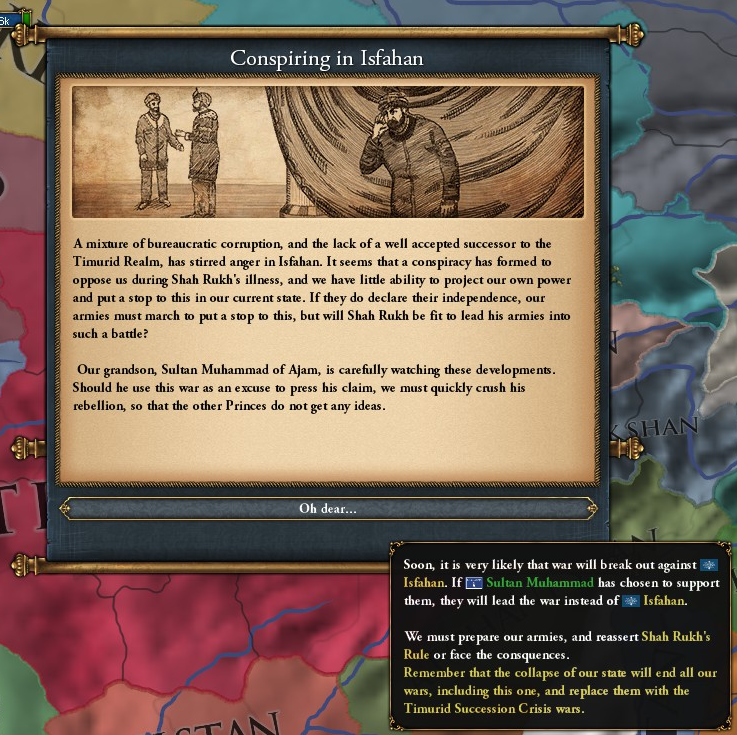 Watch the steady collapse of your kingdom unfold right before your eyes!! The Timurid Succession Crisis
Watch the steady collapse of your kingdom unfold right before your eyes!! The Timurid Succession Crisis Once the disaster fully ticks up, the Timurid State collapses, represented by a slew of unique mechanics and over 150 unique, flavorful events. In EU4, wars are typically a 1 on 1 affair, with each side bringing in their alliances. This does not effectively model the Timurid Succession Crisis, which was a constant free-for-all between the various contenders. Instead, there is a multi-way civil war, with every participant always at war with every other participant, until one contender can finally defeat the others and place themselves at the top.
The Prince and Governor distinction becomes very important here, as they have different mechanics during the civil war. The war begins with all princes declaring war on each other, and the governors getting the choice to swear fealty to a particular prince or to fight as equals. In addition, there are unique government mechanics for both, and governors can promote themselves to princes for a different ending.
In both cases, the CBs result in the subjugation of the defeated party in war, through a unique peace deal, making the loser’s realm Emirates of the winner. This build-up towards a vassal swarm results in a satisfying snowball towards the end of the war, balancing out the devastation and depletion of resources over the decade-plus of fighting. These wars are started through events, and a series of event-driven mechanics ensure that the Timurids continue fighting till one power is on top; any war that doesn’t end in total subjugation is treated as a “ceasefire” and will shortly start up again.
The map is also dynamic, with princes shattering or spitting out smaller regional states at various intervals, each of which join the Succession Crisis as a prince / governor; in fact, almost every single relevant province has an “OPM tag” associated with it, each of which have unique flags and ideas, courtesy of Cetai! These will be spit out and join the war when the right conditions are met.
 Every single OPM that can revolt just from Herat alone
Every single OPM that can revolt just from Herat aloneOf course, a fractured Timurid realm represents easy pickings for outsiders, something that certainly did happen historically with the Shaybanid conquest into Bukhara and the Turcoman conquest of the western emirs. This intervention is represented through “Interloping,” which can be done through the custom UI. A country declares their intent to intervene for a particular portion (“Region”) of the Timurid realm, as shown in the custom UI. The interloper starts a war against any prince / governor with a province in that region, and must occupy every single province in that region, at which point they can conquer the entire region and exit the war. If they lose any of these wars at any point, their conquest ends, and they leave with nothing.
[ATTACH type="full" width="734px" alt="Custom UI.png"]1110961[/attach]
A wonderful map painting minigame, in a map painting game. Ending the Succession Crisis We’ve talked about ending the succession crisis before; there are 2 main pathways to achieve this, both again through the custom UI screen. A Timurid Prince can attempt to “Reclaim Timur’s Legacy” after they have subjugated every single contender in the Civil War: this turns their tag into the Timurids and ends the wars. A Timurid Governor (or interloper) can attempt to “End Timur’s Legacy” if they have vassalized, or occupied the capital of, every Prince, which destroys the Timurid mechanics and sends a demand of subjugation to every ex-Prince and ex-Governor on the map.
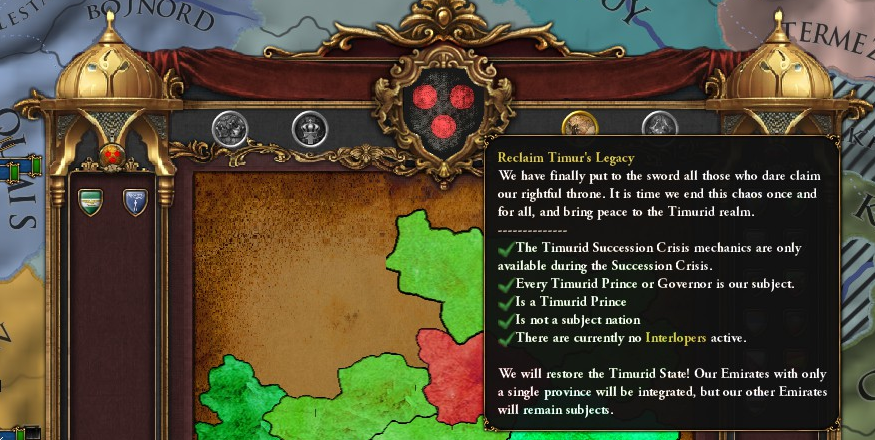 The most satisfying button click ever, trust me
The most satisfying button click ever, trust meWhile Ending Timur’s Legacy might be the end, the same cannot be said for Reclaim Timur’s Legacy. In Upon a Crimson Horse, the “Third Timurid Succession Crisis” is represented by an infinitely repeating disaster, triggering the succession crisis over and over again until no Timurids remain. This, of course, can be prevented by a skilled player, through the Government Reformation mechanics now available. A new meter, “Persianization”, is visible in the government screen; reaching +100 allows for reformation into Persia, while -100 lets the player become a centralized and powerful Horde, in the image of Timur and Genghis Khan before him. The majority of progress comes from a series of events which carry significant costs, making it a challenge not to collapse into bankruptcy or a separate disaster in time. The rewards are significant, and your united Persia/Timurids will soon be on the path to Asian domination.
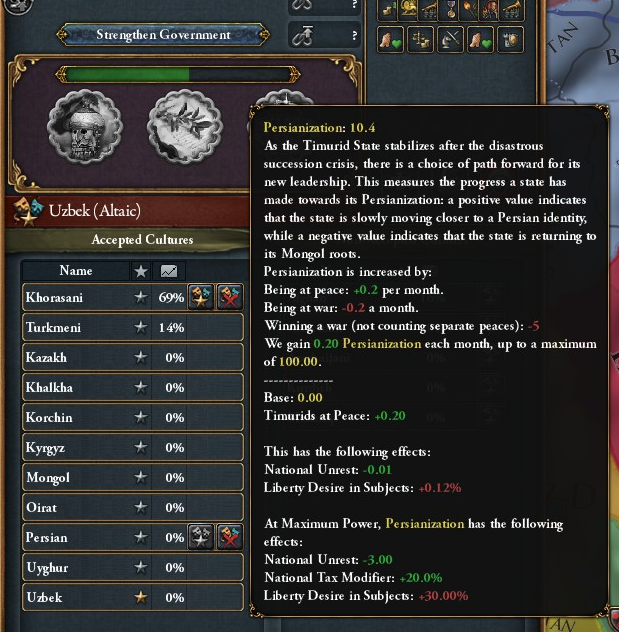 Rebels? What rebels? Oh, you mean our involuntary corps!
Rebels? What rebels? Oh, you mean our involuntary corps!We hope you enjoy playing our mod! We’ve got plans to update several of the mechanics and add some post-succession crisis content, and of course, integrate it well into the next DLC which is adding Timurid content!
The Team:
- Inferno: Lead Developer, flavor and ui
- Xorme (of Xorme AI): Art and ui
- Sol_InvictusXLII (of EU4 Minesweeper): Mechanics and Succession Crisis wars
- Cetai: flavor and events
- Minnator: events
__
We hope you enjoyed reading about these mods! You can find all of them listed here:
Upon a Crimson HorseBabur's Gate 4Professional ArmiesPax Sinica et RomanaWinds of SilkTill next time!





















